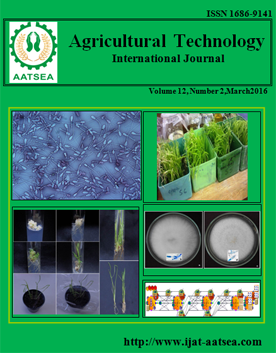Utilization of manure and green organic composts as alternative fertilizers for cauliflower production
Main Article Content
Abstract
Article Details

This work is licensed under a Creative Commons Attribution-NonCommercial-NoDerivatives 4.0 International License.
References
Bhandari, S. R. and Kwak, J. (2015). Chemical composition and antioxidant activity in different tissue of Brassica vegetables. Molecules 20:1228-1243.
Brady, N. C. and Weil, R. R. (2010). The nature and properties of soil. Prentice Hall Inc. New Jersey.
Brown, S. and Cotton, M. (2011). Changes in soil properties and carbon content following compost application: Result of on-farming sampling. Compost Science and Utilization 19:87-96.
CBSI (Central Bureau of Statistic of Indonesia) (2014). Production of vegetables and fruits in Indonesia From 1997 to 2013. Retrievd from http://bps.go.id.
Farahzety, A. M. and Aishah, H. S. (2013). Effects of organic fertilizers on performance of cauliflower (Brassica oleracea var. botrytis) grown under protected structure. Journal of Tropical Agriculture and Science 41:15-25.
Fronning, B. E., Thelen, K. D. and Min, D. H. (2008). Use of manure compost, and cover crops to supplant crop residue carbon in corn stover removed cropping systems. Agronomy Journal 100:1703-1710.
Ghorbani, R., Koocheki, A., Jahan, M. and Asadi, G. A. (2008). Impact of organic amendements and compost extracts on tomato production and storability in agroecological system. Agronomy Sustainable Development 8:307-311. Retrievd from: www.agronomy-journal.org.
Golabi, M. H., Denney, M. J. and Iyekar, C. (2004). Use of composted organic waste as alternative to synthetic fertilizers for enhancing crop productivity and agricultural sustainability on the tropical island of Guam. Proceeding of 13th International Soil Conservation Organization Conferences, Brisbane. 6 pp.
Hartatik, W. and Widowati, L. R. (2013). Manure fertilizers. In: Organic Fertilizer and Bio Fertilizers (Indonesian), Soil Research Center, Bogor. pp. 59-82.
Hue, N. V. and Silva, J. A. (2000). Organic soil amendements for sustainable agriculture: organic sources of nitrogen, phosphorus, and potassium. In: J.A. Silva and R. Uchida (eds.). College of Tropical Agriculture and Human Resources, University of Hawaii, Manoa. pp.133-143.
Invasive Species Specialist Group (2007). Sphagneticola trilobata (herb). Global Invasive Species Database. Retrievd from: http://www.issg.org/database/species/-ecology.asp?si=44.
Jahan, F. N., Shahjalal, A. T. M., Paul, A. K., Mehraj, H. and Jamaluddin, A. F. M. (2014). Efficacy of vermicompost and conventional compost on growth and yield of cauliflower. Bangladesh Research Publications Journal 10:33-38.
Louisa, M. A. and Taguiling, G. (2013). Quality improvement of organic compost using green biomass. European Scientific Journal 9:319-341.
Mahmoud, E., EL-Kader, N. A., Robin, P., Akkal-Corfini, N. and El-Rahman, L. A. (2009). Effects of different organic and inorganic fertilizers on cucumber yield and some soil properties. World Journal of Agriculture Sciences 5:408-414.
Mucheru-Muna, M., Mugendi, D., Kungu, J., Mugwe, J. and Bationo, A. (2007). Effects of organic and mineral fertilizer inputs on maize yield and soil chemical properties in a maize cropping system in Meru South Distrit, Kenya. Agroforest System 69:189-197.
Setyowati, N., Muktamar, Z., Suryanti, B. and Simarmata, M. (2014). Growth and yield of chili pepper as affected by weed based organic compost and nitrogen fertilizer. Int. Journal of Advance Science Engineering Information Technology 4:84-87.
Suparman, M. and Supiati (2004). Chemical analysis on cows’ feces using probotic technique. Proceedings of the Conference of National Technician of Agriculture (Indonesian). South Sulawesi. pp. 43-49.
Troeh, F. R. and Thompson, L. M. (2005). Soil and Soil Fertility: 6th edition. Blackwell Pub. UK.


